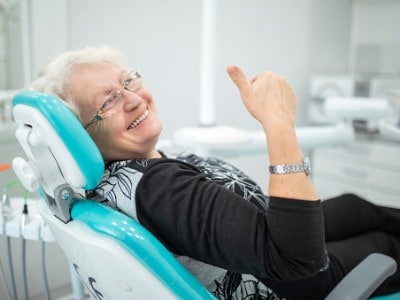
A smile is one of a person’s most defining features and there are several things you can do to slow the decline and changes that happen as you age.
- Wear and Tear
Teeth are very strong, but not indestructible. All of those years of chewing, grinding, and shredding are sure to take their toll sooner or later. These actions wear down the protective enamel coating on your teeth, which makes them more susceptible to cracking and breaking. Additionally, tooth sensitivity declines as you age, meaning you might not notice pain until things become serious.
While you cannot do much to stop the natural wear and tear of your teeth, you can greatly prevent other issues and practice good oral hygiene by brushing, flossing, and using a mouthwash regularly.
- Dry Mouth
Another change that happens with age is that the glands in your mouth begin to produce saliva less efficiently. This can also be furthered affected by some medications that have dry mouth as a side effect. A lack of saliva makes chewing and swallowing difficult, causes bad breath, and increases the risk of bacterial growth, tooth decay, and cavity formation. Dry mouth can also make your teeth wear and lose shape easier. Fortunately, regularly drinking water is an effective way to keep your mouth moist. You can also chew on sugarless gum to stimulate saliva production. Be sure to stay away from caffeine, alcohol, and tobacco.
- Yellow Teeth
Perhaps everyone’s least favorite side effect of tooth aging, the yellowing of those pearly whites. Yellowing teeth are cause partially by the yellowing of the dentin inside the tooth that can show through as the enamel wears down. Yellow teeth are often the result of staining by coffee, wine, tea, and tobacco. Fortunately, they are several whitening options out there such as whitening toothpastes and whitening strips. However, be sure to consult a dental professional before choosing a bleaching agent.
- Oral Cancers
Older people are at a much greater risk of developing cancers of the mouth, jaw, tongue, and throat. As you get older, it is very important to get regular dental screenings. These give you a better chance of catching things before they become more serious.
- Shifting Teeth
As you age, you may find that your teeth begin to shift place. This is due to the fact the bones of the upper and lower jaw naturally weaken with age. As these bones get weaker, teeth gradually begin to shift inwards and can turn. Fortunately, orthodontic care devices, such as braces, are a good way to fix your teeth from the ways they may have shifted with age.
We’re here to help and happy to answer any questions you may have about tooth aging or how to keep your smile looking young. Contact our office for more information!